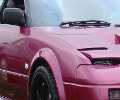Please read this chaps,something new in the 1.5 world has come to our attention.Stu contacted me to show me pics of his chassis area where the front and rear torque mounts attach,and one of the captive nut areas in the chassis have fractured and broken away.He spotted this while changing the clutch.Its the first time we have ever seen this on any 1.5,and i mean worldwide!!!
And the rear chassis has a slight crack forming around the captive nut...
Now before everyone starts panicking dont worry,this car is driven to the very limit on the drag strip and on track so penelope really gets some serious hammer time! the torque mounts are taking the full brunt of those hard launches.Also this car is running at a lot higher torque level than most,that too is a contributing factor.What we dont quite understand is why no other 1.5 in the world has shown this fault up to now? There are some pretty high power 1.5's out there and none of them have done this....so its a bit confusing.Niks rev3 is running 290bhp and has no signs of this at all.
Both stu and i though it was in everyones best interests to make this known as its something completely new in the 1.5 world.
Regular 1.5's running normal power need not worry about this at all,i ran mine for years with no problems at all,as have many other owners throughout the world.
This warning needs to go out to anyone thinking of running plus 280bhp and competing in motorsport events.
The solution is very simple indeed,all we need to do is weld some 3mm plate over these areas to beef them up a little,probably take an hour or two maximum.Certainly theres no design flaw with the torque mounts or anything,it seems in penelopes case the front torque mount rear bolt was taking too much load under hard launches...so we need to spread that load with thicker wider plating in these areas.
Many thanks to stu for bringing this one to our attention,his car is certainly maxing out 1.5 testing for all of us :thumbsup:











 Reply With Quote
Reply With Quote










